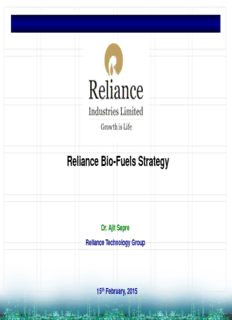
Dr Ajit Sapre, Group President R&T, Reliance Industries Ltd PDF
Preview Dr Ajit Sapre, Group President R&T, Reliance Industries Ltd
Reliance Bio-Fuels Strategy Dr. Ajit Sapre Reliance Technology Group 15th February, 2015 2 Biofuel drivers for RIL Energy security (India imports 75% crude oil) Reduce forex outgo Rural upliftment Maximum value generation from Indian land mass No food versus fuel competition Climate change mitigation Bio-fuels key to sustainably meet hydrocarbon demand & improve farmers’ livelihood 3 Sustainable development challenge More, Secure and Responsible technology needed for India OECD (17% world population) Industrialization Traditional and personal mobility take off Unsustainable Economic growth China requires little additional energy d Sustainable n a Leapfrogging m e Efficient d Services dominate y g growth and basic Renewable re Urbanization households energy Technology n E needs are met Development & Deployment Non-OECD (83% world population) (Solar, Wind, India Biomass) 3,000 10,000 15,000 25,000 GDP/Capita in constant PPP terms Demand for materials & energy is growing rapidly as developing countries like India enter their most energy-intensive phase of economic development 4 Future of liquid hydrocarbons? Light Food Heat House Clothes Sustainability & energy security two sides of the same coin 5 RIL: A significant commitment to renewables R&D, major focus on advanced biotechnology Two hundred scientists and engineers working in India, trained in the best institutions globally International collaborations with top notch institutions, leveraging talent of additional two hundred and fifty scientists and engineers No food vs. fuel competition Surplus agri-residue (>100 MM MTpa biomass resulting in >25 MM MTpa biofuel) Jatropha (develop high yield varieties in low rainfall marginal land areas) Algae (use sea-water and desert land at coastline) Adopt PM’s triple S mantra: Skill, Scale and Speed for these challenging problems Algae oil Agri-residue to kerosene Jatropha to bio-diesel Algae to bio-crude RIL committed to largest cutting-edge R&D program by any private enterprise to help India leap-frog 6 Thermochemical route is economically attractive Syngas or Catalytic Pyrolysis • In the Indian context thermochemical routes may be more attractive than cellulosic fermentation due to types of non feed/ fodder bio-mass availability • Business model innovation: distributed production and consumption at village level Thermochemical route can improve overall carbon utilization efficiency to end products 7 Agri-residue conversion to modern energy Feed Stock Technology De-Construction Upgrading Product Biomass to Power 1 KG = 1.7 KW = 1465 KCAL Combined Cycle Biomass Power Power generation Biomass to Ethanol 1 KG = 252 GRAM = 1780 KCAL Agri-residues Enzymatic Hydrolysis Fermentation Ethanol Non-fodder/ food- stalks, trash and bagasse Biomass to HC Fuel 1 KG = 280 GRAM = 2960 KCAL Catalytic Pyrolysis Hydrotreatment Gasoline/Diesel/ Kerosene Converting biomass to fungible hydrocarbons like kerosene is more efficient technology 8 Agri-residue conversion to hydrocarbons more valuable than burning Burning is a cheap and quick way to clear field but leads to loss of nutrients and pollution Images from The Guardian NASA image showing fire hot-spots (red dots) Pollution in Delhi Source: NASA, Hindustan Times Nov 7, 2013 Excess agri-residues can be converted to kerosene at village level 9 Bio-feedstock aggregation/ supply opportunity • Farm & Farmer Coordination Farm Harvesting Seasonal • Manual Labor • Aggregation Short window Distributed Bulky Biomass surplus >100 million tons per annum Bio-fuels potential >25 million • Transport • Weeding tons per annum Collection • Accounting Moisture, Grits, Collection and processing of Foreign Matter, • Sizing biomass is estimated to create Timing additional income stream of at least Rs. 20,000 crore per year • Drying for the rural economy • Stocking Preparation • Planning Loss, Capacity • Transporting Utilisation, Synchronize Innovative business models for supply chain, logistics and cost competitiveness 10 Jatropha crop improvement RIL Jatropha Germplasm collection Classical Hybrids Individual collection Random lines Hybrids Development hybrids Goals Mutagen- esis •Virus tolerance •Year round flowering •Good Branching pattern •Variability •Suitability to different Agro climatic Zones Top Selected elites 151 lines collected 195 lines collected from 17 states from 11 countries Primary objective is to Develop high yielding pest and disease tolerant hybrid for rain fed conditions P1 Jatropha curcas P2 Jatropha integerrima Tissue Culture Hybrids Green flower Pink flower Phase - I X Developing robust and reproducible Tissue Culture protocols for the rapid multiplication of parental lines Developing Single Sequence Repeat and other markers to facilitate the Screening efficiencies Phase - II Metabolic engineering for lipid expression and photosynthetic efficiency F1 cream flower Heat and salt tolerance constructs Both Rain-fed & Support Irrigation Hybridization using world-wide Jatropha germplasm and tissue culture to improve yields and robustness
Description: